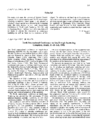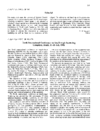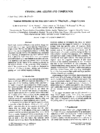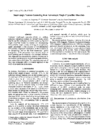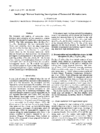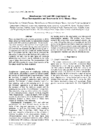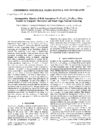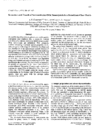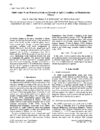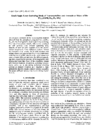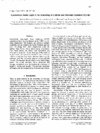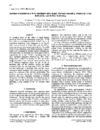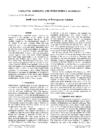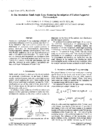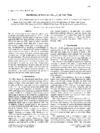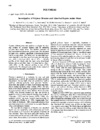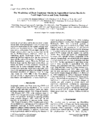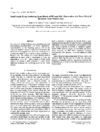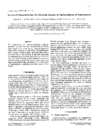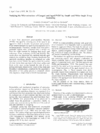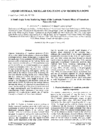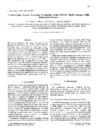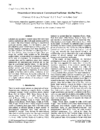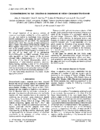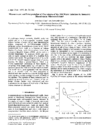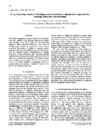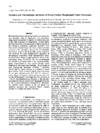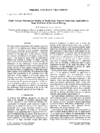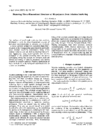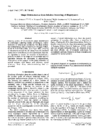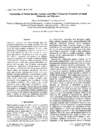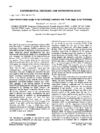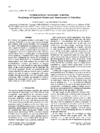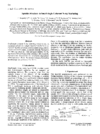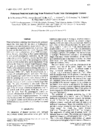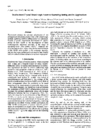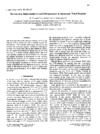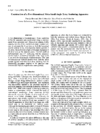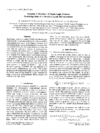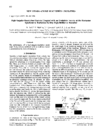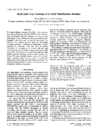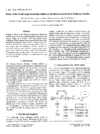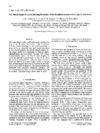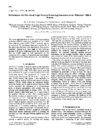issue contents
October 1997 issue

editorial
Free 

international union of crystallography
Free 

research papers
The temperature dependence of the magnetic penetration depth in a superconducting YBa2Cu3O7−δ single crystal has been obtained in different fields by small-angle neutron diffraction.
From analysis of two-dimensional SAS patterns of decomposing single-crystalline materials, one can extract important information on the evolution of the morphology and on the three-dimensional spatial arrangement of the precipitates from early stages of decomposition. The real-space information obtained from transmission electron microscopy complements excellently the reciprocal-space information extracted from SAS data.
SANS is demonstrated to be a powerful tool for investigations of nanoscaled microstructures by in situ annealing and magnetic contrast variation on two amorphous multicomponent alloys.
Simultaneous small-angle scattering (SAS)/100 experiments on the decomposition and reversion in Al–Li alloys have been performed. Relationships between SAS and 100 profiles are presented for the precipitation structure.
In situ reversion experiments on very small (1nm) GP zones in Al–Zn have been performed by using time-resolved synchrotron-radiation small-angle scattering measurements. A rapid increase in the Guinier radius with decreasing integrated intensity has been observed.
A small-angle neutron scattering study of the microstructure of ordered cuboidal γ' precipitates in the heat-treated single-crystal Ni-based superalloy ZS26 is described.
The small-angle neutron scattering results obtained from a steady-state reactor (at ILL, Grenoble, France) and from a pulsed source (at RAL, Didcot, Oxon, England) are compared. Good agreement was obtained although different acquisition techniques and different data-treatment procedures were used.
Small-angle neutron scattering has been successfully used for the microstructural characterization of a martensitic steel for fusion reactors.
The decomposition kinetics of bulk amorphous Zr41Ti14Cu12.5Ni10Be22.5 are studied with SANS and the results are interpreted with the aid of computer simulations. A distribution of the precipitates is found to be a possible explanation for the measured SANS data during annealing in the undercooled liquid regime.
Uniformly enhanced small-angle X-ray scattering intensities of amorphous SiO2, measured following irradiation at room temperature with low-fluence 320 keV H+ and He+ beams, suggest that the radiation-induced defect structure is compatible with the presence of essentially totally preserved instantaneously produced interstitial-like O and Si atoms and complementary O and Si vacancy-like sites.
The formation and mechanism of growth of PbTe nanocrystals embedded in a borosilicate glass matrix were studied by SAXS. The results concerning the time dependence of nanocrystal radius are compared with those obtained using optical absorption spectroscopy.
The additional absorbance spectra of samples exposed to ultraviolet light show that the silver colloid formation is possible only in samples that exhibit SAXS curves characteristic of well defined particles dispersed in glass.
Amorphous metallic ribbons produced with different quenching rates from the melt of Fe73.5CuNb3Si13.5B9 were studied by small-angle X-ray scattering. The structural evolution due to alloy crystallization was studied by SAXS measurements carried out in situ during isothermal annealing.
In situ experiments reveal the structure and lattice parameters of colloidal crystals and the internal structure of highly monodisperse colloidal particles. This is important for interpreting optical experiments.
X-ray reflectivity and interface diffuse scattering from a W/Si amorphous multilayer exposed to a series of rapid thermal annealings have been measured and the interface evolution studied up to the collapse of the multilayer stack.
A review of small-angle scattering results of heterogeneous catalysts is presented.
Size distributions of electro-oxidized and reduced carbon- supported Pt catalyst particles are examined by in situ ASAXS studies in electrochemical cells.
This paper presents the size distribution function of voids in hydrogenated amorphous silicon carbide films deposited by PECVD from mixtures of silane and methane.
A small-angle X-ray scattering study of the isothermal evolution of nano and mesoporosities in monolithic SnO2 gels is presented.
The structure of ZrO2SiO2 gels starting from the parent molecular material via the resulting amorphous system up to the final crystalline structure was investigated using X-ray scattering methods and reverse Monte Carlo simulations.
In situ combined SAXS/WAXS experiments showed the aging time at room temperature to influence the crystallization kinetics at reaction temperature, but not the formation of colloidal aggregates. The reverse was observed upon dilution.
The effect of shear on the chain conformation in polymer brushes and adsorbed layers is discussed. A neutron reflection technique was used to probe the polymer profiles in situ under shear.
Formation of b.c.c. morphology of the network nodes in physical gels is controlled by the elastic interaction between them and depends on the conformation of the linking polymer chains.
The morphology of block copolymer micelles in supercritical carbon dioxide was studied via small-angle-scattering techniques as a function of solvent density, block length and concentration.
The temperature and pressure dependencies of thermal composition fluctuations were measured in a binary homopolymer blend and in a diblock copolymer by small-angle neutron scattering. The phase diagram, the Ginzburg number and the Flory–Huggins interaction parameter were determined.
The phase behavior of polymer systems as studied by SANS and SAXS is reviewed. The review includes polymer blends, block copolymers and more complex systems like block copolymers mixed with homopolymers or selective solvents.
In the SAXS of modified poly(ethylene) (blends) a peculiar and reproducible deviation from Porod's law is found. The strength of this effect is a function of blend composition.
The interaction parameters were determined for SAXS measurement of poly(N-isopropylacrylamide) in mixed solvents. The contributions of the segment–segment interactions to the entropy and enthalpy have been calculated.
The morphology of sodium partially and totally neutralized carboxytelechelic ionomers has been characterized by small-angle X-ray scattering showing that the aggregates grow as more end chains are neutralized while keeping the electron density constant, in agreemeent with the multiplet model.
During service, extruded commercial PVDF loses plasticizer. Emerging voids and decreasing contrast between amorphous and crystalline phases result in considerable variations of the SAXS.
Aqueous suspensions of vanadium pentoxide (V2O5) display a lyotropic nematic phase. Small-angle X-ray scattering gives useful information on the building blocks and the organization of this phase.
A description of different synchrotron radiation facilities available for the determination of phase states and mechanisms of phase transitions of polar lipids of biological significance in aqueous systems is given.
Small-angle neutron scattering was performed on rodlike tetra- decyldimethylaminoxide micelles in D2O at different temperatures and hydrostatic pressures up to 840 MPa.
Small-angle neutron scattering has been used to investigate shear-induced structures in concentrated micellar phases. In the lamellar phase of the non-ionic surfactant hexaethylene glycol monohexadecyl ether, a novel biaxial orientation of the lamellae with shear is observed, whereas for a cationic–non-ionic mixture, the shear-induced formation of multi-lamellar vesicles is observed.
The SAXS study of thermostimulated sol–gel–sol transitions of aqueous solutions of zirconyl chloride modified by sulfuric acid gave evidence that gelation is due to electrostatic interaction during cluster–cluster aggregations.
The interfacial curvatures of oil–water interfaces in bicontinuous microemulsions were measured using small-angle neutron scattering.
Small-angle neutron scattering experiments were performed on micellar solutions of octyl-β-glucoside (OBG) in water and on solutions of OBG + glycine in water.
A system for position-resolved small-angle scattering on biological materials is described. The application is demonstrated with measurements on a human vertebra and on the branch of a spruce tree.
The usefulness of the X-ray method is explored for studying the structure of proteins in solution. In particular, de nuovo structure determination is investigated.
Phosphatidylcholines and sphingomyelins are among the most abundant phospholipids of mammalian cell membranes and are major components of the lipid monolayer of lipoproteins. Their interaction has been studied by microcalorimetry and X-ray diffraction in order to characterize these biomembrane-mimetic systems.
The quaternary structure transition of the allosteric enzyme ATCase has been titrated with various combinations of substrate analogues, using an area detector. The transition appears to be concerted regardless of the substrate analogues used. The ATCase–CP complex is shown to adopt a quaternary structure different from, although similar to, the T structure of the unligated enzyme.
The experimental possibilities of the triple isotopic substitution method in small-angle neutron scattering are investigated.
Novel approaches allowing the determination of the low-reso- lution shape and internal structure of biopolymers from solution-scattering data are reviewed.
Practical aspects of low-resolution shape determination are considered and examples of its applications for biopolymers in solution are presented.
The importance of volumetric properties and possible methods of predicting them are discussed. A universal approach, which allows the ab initio calculation of the volumes of different types of molecules, and special procedures for proteins are described in more detail.
The determination of the particle-size distribution from small-angle scattering data is discussed.
A program for three-dimensional rendering and interactive model refinement that allows the display and manipulation of low-resolution and of atomic models is presented.
Time-resolved simultaneous SAXS and WAXS experiments are described, with a discussion of problems encountered on third-generation synchrotron radiation sources.
Grazing-incidence small-angle scattering of X-rays (GISAXS) is a nondestructive surface-analysis technique that allows size measurements of scattering entities of mesoscopic scale.
A first feasibility study of intensity-fluctuation spectroscopy for small-angle coherent X-ray scattering is described. A polymer and a metallic alloy were used as test cases.
It is demonstrated how interference phenomena at total reflection, leading to X-ray standing-wave generation and waveguide mode formation inside the layered structure and responsible for a modulation of X-ray reflection and fluorescence angular dependence, can be used for nano-film characterization.
In dynamically polarized proton spin targets, reversal of nuclear polarization by adiabatic fast passage produces polarization gradients around paramagnetic centers. These can be used as labels in polarized neutron diffraction.
Theoretical relations for optimum adjustments of a double-bent-crystal small-angle neutron scattering diffractometer, as well as for transformation of the cross section to the measured intensity, are described. The applicability of the technique in materials research is demonstrated.
With a double-crystal diffractometer equipped with lamellae crystals as monochromator and analyzer, an intensity gain of 5.4 was realized and the investigation of Ni domains improved. A good estimate of the Bloch wall thickness can be given.
A two-dimensional ultra-small-angle X-ray scattering apparatus was constructed using a rotating-anode X-ray generator and a Bonse–Hart camera with two sets of two channel-cut single crystals.
A procedure is proposed to calibrate small-angle neutron scattering data collected at double-crystal diffractometers. It is based on the incident flux measured without sample. Data calibration is tested for the scattering of an Ni-based superalloy.
The performance of a high-angle-resolution small-angle scattering (USAXS) camera on the high-brilliance beamline ID2 at ESRF is exemplified.
The small-angle scattering station of the ESRF high-brilliance beamline (BL4/ID2) is described. Absolute scattering intensities are used to describe the achievable signal-to-background ratio.
A new high-flux wiggler beamline for small-angle X-ray scattering (SAXS) has been commissioned at ELETTRA, Trieste, Italy.
A small-angle X-ray scattering instrument at the Beijing Synchrotron Radiation Facility is described along with the results of some studies of biomembranes.
The design, construction and preliminary characterization of the LNLS beamline are described.
The set-up and alignment of a new small-angle neutron scattering instrument, installed at the 1 MW light-water-moderated MINT TRIGA research reactor, are described.


 journal menu
journal menu









